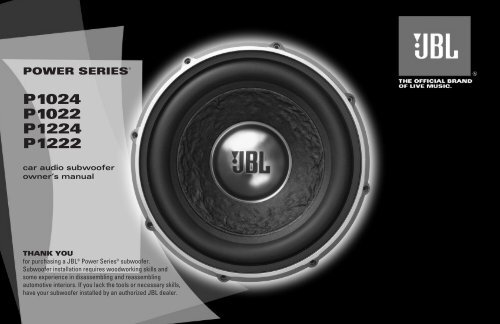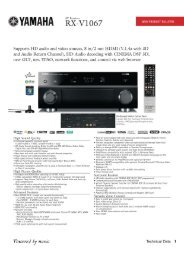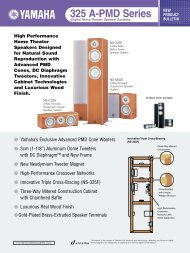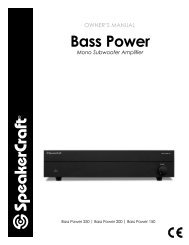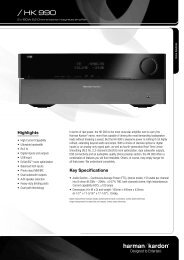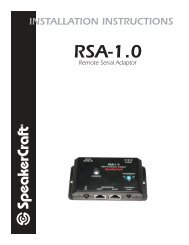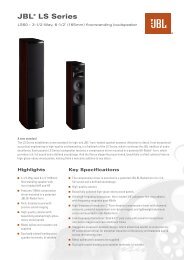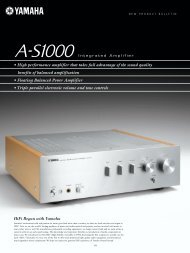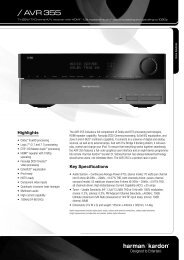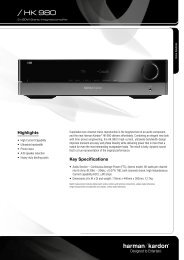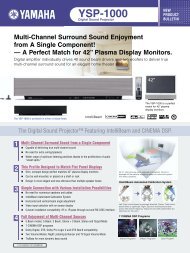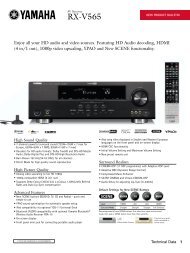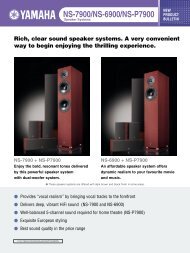Owners Manual - JBL.com
Owners Manual - JBL.com
Owners Manual - JBL.com
You also want an ePaper? Increase the reach of your titles
YUMPU automatically turns print PDFs into web optimized ePapers that Google loves.
POWER SERIES ®<br />
P1024<br />
P1022<br />
P1224<br />
P1222<br />
car audio subwoofer<br />
owner’s manual<br />
THANK YOU<br />
for purchasing a <strong>JBL</strong> ® Power Series ® subwoofer.<br />
Subwoofer installation requires woodworking skills and<br />
some experience in disassembling and reassembling<br />
automotive interiors. If you lack the tools or necessary skills,<br />
have your subwoofer installed by an authorized <strong>JBL</strong> dealer.
CHOOSING AN ENCLOSURE<br />
WARNING: Playing loud music<br />
in an automobile can permanently<br />
damage your hearing as well as<br />
hinder your ability to hear traffic.<br />
We re<strong>com</strong>mend listening at low<br />
levels while driving. <strong>JBL</strong> accepts no<br />
liability for hearing loss, bodily injury<br />
or property damage resulting from<br />
use or misuse of this product.<br />
Power Series subwoofers are<br />
optimized to perform best in small,<br />
sealed, vented and prefabricated<br />
bandpass enclosures. While<br />
infinite-baffle mounting of<br />
Power Series subs is possible,<br />
power handling will be greatly<br />
<strong>com</strong>promised because there’s no<br />
enclosed volume of air to prevent<br />
the speaker’s cone from moving<br />
past its limit. For this reason, we<br />
do not re<strong>com</strong>mend infinite-baffle<br />
mounting for Power Series<br />
subwoofers.<br />
You should choose the enclosure<br />
you will use based on the type of<br />
music you listen to, how much<br />
amplifier power you will use for the<br />
subwoofer and how much space<br />
inside the vehicle you can devote<br />
to a subwoofer enclosure.<br />
Because a sealed enclosure<br />
provides the most control over<br />
the woofer’s movement, a woofer<br />
mounted in a sealed enclosure will<br />
handle more power than a woofer<br />
mounted in another enclosure type.<br />
Sealed enclosures provide more<br />
accurate sonic reproduction than<br />
other enclosure types, so they are<br />
well suited to all types of music.<br />
Sealed-enclosure construction<br />
is straightforward and there<br />
are many prefabricated sealed<br />
enclosures available. An optimum<br />
sealed enclosure is always smaller<br />
than other types of enclosures<br />
optimized for a particular speaker,<br />
so they require the smallest amount<br />
of space inside the vehicle.<br />
Vented enclosures provide better<br />
efficiency in the 40Hz – 50Hz range<br />
but this efficiency <strong>com</strong>es at the<br />
expense of sound in the lowest<br />
octave (below 40Hz) and at the<br />
expense of some control and power<br />
handling. If you are using a small<br />
amplifier, a vented box will provide<br />
more bass output from less power.<br />
Vented enclosures are also well<br />
suited to a variety of music types.<br />
Because vented enclosures require<br />
the volume of the enclosure and the<br />
size of the port to have a specific<br />
relationship with the characteristics<br />
of the woofer, the enclosure must<br />
be built exactly to the specifications<br />
provided. While there are some<br />
prefabricated vented boxes<br />
available, matching a prefabricated<br />
box to a particular woofer is difficult.<br />
If you wish to use a vented enclosure,<br />
we strongly re<strong>com</strong>mend having your<br />
authorized <strong>JBL</strong> dealer build it, or<br />
verify that your design is correct<br />
if you wish to build it yourself. An<br />
optimum vented enclosure is always<br />
larger than the optimum sealed box<br />
for the same woofer and will require<br />
more space inside the vehicle.<br />
Bandpass enclosures often<br />
provide the most output available<br />
from any amplifier and subwoofer<br />
<strong>com</strong>bination at the expense of<br />
sonic accuracy. If sheer SPL<br />
(sound-pressure level) is what you<br />
desire most, choose a bandpass<br />
enclosure. Bandpass-enclosure<br />
design is very tricky and the aid<br />
of a <strong>com</strong>puter and enclosure<br />
design software is necessary. If<br />
you are an experienced installer<br />
or have some woodworking<br />
experience, you may wish to build<br />
the enclosure described in the<br />
enclosure design sheet included<br />
with this woofer. Fortunately, there<br />
are many prefabricated bandpass<br />
boxes available and they are all<br />
optimized to extract the most<br />
output possible from any woofer.<br />
Bandpass enclosures can be quite<br />
large and may require a lot of space<br />
inside your vehicle.<br />
2
CONNECTING YOUR SUBWOOFER TO YOUR AMPLIFIER<br />
<strong>JBL</strong> Power Series subwoofers<br />
are available in two different<br />
configurations: as dual 4-ohm voice<br />
coils or as dual 2-ohm voice coils.<br />
Depending on the amplifiers you are<br />
using, you may use Power Series<br />
subwoofers in singles or multiples<br />
to maximize the power available<br />
from your amplifiers. To achieve the<br />
maximum amplifier output possible,<br />
you should design a speaker system<br />
that provides the lowest impedance<br />
that your amplifier is rated to drive<br />
safely. When designing a subwoofer<br />
system, consider the following rules:<br />
1. Don’t mix different subwoofer<br />
or enclosure types in the same<br />
system (use all dual 4-ohm<br />
woofers or all dual 2-ohm<br />
woofers).<br />
2. You may connect the coils of a<br />
dual-voice coil woofer in series,<br />
but we re<strong>com</strong>mend that you<br />
avoid connecting separate<br />
woofers in series.<br />
3. You must use both coils of a dualvoice<br />
coil woofer connected<br />
either in series or in parallel.<br />
4. Most amplifiers deliver exactly<br />
the same amount of power<br />
bridged into a 4-ohm load<br />
as they do running a 2-ohm<br />
stereo load.<br />
To design a subwoofer system<br />
that maximizes available amplifier<br />
power, keep the following rules<br />
in mind:<br />
1. The total system impedance<br />
of woofers in parallel =<br />
1<br />
1 + 1 + 1<br />
w<br />
...<br />
1 w 2 w 3<br />
where w is the nominal<br />
impedance of the woofer.<br />
2. The total system impedance<br />
of voice coils (or woofers) in<br />
series = w 1 + w 2 + w 3 ...<br />
The diagrams to the right<br />
show parallel and series<br />
speaker connections.<br />
Figure 1. Parallel connection<br />
POS ( + )<br />
POS ( + ) NEG ( – )<br />
NEG ( – )<br />
PARALLEL CONNECTION<br />
PARALLEL CONNECTION<br />
Figure 2. Series SERIES connection<br />
CONNECTION<br />
SERIES CONNECTION<br />
POS ( + )<br />
NEG ( – )<br />
POS ( + )<br />
NEG ( – )<br />
3
SPECIFICATIONS<br />
P1024 P1022 P1224 P1222<br />
10" Dual 4-Ohm 10" Dual 2-Ohm 12" Dual 4-Ohm 12" Dual 2-Ohm<br />
Voice-Coil Voice-Coil Voice-Coil Voice-Coil<br />
Subwoofer Subwoofer Subwoofer Subwoofer<br />
Power Handling, RMS 400W 400W 400W 400W<br />
Power Handling, Peak 1200W 1200W 1200W 1200W<br />
Sensitivity (2.83V/1m) 92dB 96dB 94dB 97dB<br />
Frequency Response 25Hz – 500Hz 25Hz – 500Hz 25Hz – 450Hz 23Hz – 450Hz<br />
Impedance 8 Ohms/2 ohms 4 Ohms/1 ohm 8 Ohms/2 ohms 4 Ohms/1 ohm<br />
Mounting Depth 6-1/4" (159mm) 6-1/4" (159mm) 6-1/4" (159mm) 6-1/4" (159mm)<br />
Cutout Diameter 9-1/16" (231mm) 9-1/16" (231mm) 11-1/16" (281mm) 11-1/16" (281mm)<br />
Overall Diameter 12-7/16" (316mm) 12-7/16" (316mm) 14-5/8" (372mm) 14-5/8" (372mm)<br />
Features, specifications and appearance are subject to change without notice.<br />
<strong>JBL</strong> Consumer Products<br />
250 Crossways Park Drive, Woodbury, NY 11797 USA<br />
516.255.4<strong>JBL</strong> (4525) (USA only) www.jbl.<strong>com</strong><br />
© 2005 Harman International Industries, Incorporated. All rights reserved.<br />
<strong>JBL</strong>, Harman International and Power Series are trademarks of<br />
Harman International Industries, Incorporated, registered in the<br />
United States and/or other countries.<br />
Part No. P1022/1024/1222/1224OM8/05<br />
Declaration of Conformity<br />
We, Harman Consumer Group International<br />
2, route de Tours<br />
72500 Chateau du Loir<br />
France<br />
declare in own responsibility that the products described in this owner’s<br />
manual are in <strong>com</strong>pliance with technical standards:<br />
EN 61000-6-3:2001<br />
EN 61000-6-1:2001<br />
Klaus Lebherz<br />
Harman Consumer Group International<br />
Chateau du Loir, France 8/05<br />
www.jbl.<strong>com</strong>


